How To Master Small Business Lead Generation? (Detailed Guide for Business Owners)
Here it is—the step-by-step guide to small business lead generation you were looking for. Find new tips, tactics, and strategies to help you generate more leads.
— Propoze

Wondering how to master lead generation for your small business?
It’s all about getting a steady flow of customers to boost sales and grow.
In today’s tough market, generating high-quality leads is crucial for small business success.
We’ll cover easy tips and tools to get you ahead.
So, let’s get started!
Key things you need to take away from this article
- Effective lead-generation strategies for small businesses include content marketing, SEO, social media, and email marketing, each offering unique advantages for attracting and converting leads.
- The selection of the right tools and software is really important for implementing lead generation strategies efficiently.
- Measuring success through analytics and key metrics is essential for optimizing lead generation, while staying informed about future trends is necessary to stay competitive.
Key strategies for small business lead generation
Lead generation is, without a doubt, one of the most important (and most difficult) parts of running a small business.
Here's a cool graph showing you exactly which methods proved to be the most effective - and the most difficult to execute.

Integrating digital tools
When you blend various digital tools effectively, it can take your lead generation to the next level. Introducing lead capture techniques is crucial for optimizing forms and processes to collect user information, thereby enhancing conversion rates.
We’re here to walk you through how to mesh CRM, SEO, and content marketing platforms into a solid strategy for attracting leads.
By syncing these tools, you’ll find your processes more streamlined, your sales pipeline enhanced, and your relationships with customers deepening and becoming more enduring.
Integrating CRM systems
Our goal is to centralize lead generation data to enhance customer relationship management.
1️⃣ Choose a CRM that integrates seamlessly with your existing marketing platforms.
2️⃣ Import existing clients and new leads into the CRM to create a unified database.
3️⃣ Set up lead scoring within your CRM to prioritize qualified leads based on their engagement and conversion potential.
4️⃣ Utilize CRM data to personalize outreach campaigns and follow-ups, increasing the likelihood of converting potential customers into loyal customers.
Leveraging SEO tools
Our goal is to optimize your online presence to attract more new leads through organic search.
1️⃣ Integrate and Automate SEO Tools:
Combine tools like Google Analytics, Google Search Console, and SEMrush or Ahrefs to create a seamless data analysis system. Automate regular performance reports to identify patterns and optimize efforts without manual intervention.
2️⃣ Perform a Comprehensive Site Audit:
Use SEO audit tools (e.g., Screaming Frog, Sitebulb) to find technical issues like broken links, missing meta tags, or slow-loading pages. Fixing these issues improves site health and boosts search engine visibility.
3️⃣ Target Local and Niche Keywords:
Beyond general keywords, optimize for local SEO (if applicable) by targeting location-based searches. Use tools like Moz Local to improve your presence in local search results. For broader appeal, focus on niche, intent-driven keywords that address customer pain points.
4️⃣ Optimize Content for User Intent:
Use keyword insights to create various types of content (blog posts, FAQs, case studies) aligned with specific user intents—whether informational, navigational, or transactional. Ensure content is well-structured with H2s, bullet points, and schema markup.
5️⃣ Implement Backlink Strategies:
Track competitor backlinks using tools like Ahrefs and develop a backlink strategy by building relationships with reputable sites, writing guest posts, or creating shareable infographics and studies.
6️⃣ Measure ROI on SEO Efforts:
Go beyond traffic and rankings. Use advanced tracking to measure lead generation metrics directly tied to SEO campaigns, such as form submissions or sales conversions.
Utilizing content marketing platforms
We want to streamline content creation and distribution to engage and nurture leads.
1️⃣ Choose a Multi-Functional Content Marketing Platform:
Select a platform like HubSpot, CoSchedule, or ContentStudio that integrates seamlessly with your CRM, email marketing tools, and SEO analytics platforms. This ensures a unified workflow for planning, publishing, and analyzing content.
2️⃣ Create a Data-Driven Content Calendar:
Develop a content calendar informed by keyword research, seasonal trends, and audience insights. Include a mix of formats like blogs, videos, case studies, and infographics to cater to different audience preferences.
3️⃣ Foster Cross-Team Collaboration:
Share real-time content insights across marketing, sales, and customer service teams. Use collaborative tools like Trello or Asana to ensure alignment on tone, goals, and audience needs, making every piece of content purposeful.
4️⃣ Leverage Distribution Channels Effectively:
Utilize automation to distribute content across multiple channels, including social media, email campaigns, and paid ads. Tailor messaging for each platform to improve reach and engagement.
5️⃣ Analyze and Iterate for Better Results:
Use analytics tools like BuzzSumo, Google Analytics, and the platform's native insights to measure performance metrics such as shares, clicks, and conversions. Identify top-performing topics and formats, then double down on similar content for higher ROI.
By effectively integrating your digital tools, you position your business as the best lead generation company that not only attracts new leads but also nurtures them through the sales pipeline efficiently.
This holistic approach makes sure that every touchpoint with a potential customer is informed, relevant, and coordinated, significantly boosting chances of conversion.
Content marketing lead generation strategy
We can confidently claim — content has a role of a powerful magnet that attracts potential leads.
For small businesses, the art of content marketing is not just about creating noise; it’s about crafting a symphony that resonates with the audience.
Lead generation services can significantly enhance content marketing efforts by providing targeted marketing and analytics to attract and convert potential customers.
1️⃣ Identify and Understand Your Audience:
Create detailed audience personas to define your ideal customers, including their demographics, pain points, and goals.
Use tools like Google Trends or AnswerThePublic to research their questions and interests. This ensures your content addresses their real needs.
2️⃣ Create Purpose-Driven Content:
Develop a mix of content formats like blog posts, infographics, e-books, and videos tailored to your audience's preferences.
Ensure every piece of content solves a specific problem, offers actionable advice, or demonstrates your expertise.
Optimize content with relevant keywords to improve visibility on search engines and attract organic traffic.
3️⃣ Engage and Convert Visitors into Leads:
Add compelling call-to-action (CTA) buttons, such as “Download Our Free Guide” or “Start Your Free Trial,” at strategic points in your content.
Use minimal form fields on landing pages to reduce friction and boost lead conversions.
Incorporate interactive elements like quizzes, calculators, or live chat to engage users and capture leads dynamically.
4️⃣ Leverage Distribution Platforms:
Use platforms like HubSpot or Buffer to automate content sharing across social media and email channels.
Pair content with email drip campaigns to nurture leads, delivering the right message at the right stage of their journey.
5️⃣ Track and Optimize Performance:
Measure success using metrics like traffic, engagement rates, and conversions. Tools like Google Analytics and SEMrush can provide insights into which content performs best.
Continuously refine your content strategy based on audience feedback and analytics to improve ROI.
By consistently delivering valuable and engaging content, small businesses can capture the attention of potential leads and nurture them through the buyer’s journey.
Remember, lead generation tools for small businesses are only as effective as the content they distribute. Use platforms like HubSpot to amplify your reach and leverage their email marketing capabilities to keep your audience engaged.
With the right strategies for small business customer acquisition and lead generation, you’ll see your efforts pay off in a growing list of potential clients.
Small business content marketing examples
In the case of small business lead generation, content marketing stands out as a pivotal strategy, offering a blend of creativity, engagement, and value to potential customers.
Nurturing leads through content marketing is essential, as it helps convert potential customers into loyal clients by providing valuable and relevant information.
Below are two compelling case studies from small businesses that harnessed the power of content marketing to boost their lead generation efforts, along with actionable insights you can apply to your strategy.
Birchbox: A beauty subscription success story
Birchbox, a New York City-based beauty subscription service, transformed its initial $1.4 million investment into a valuation exceeding $485 million, largely through adept content marketing.
Their approach includes daily blog posts on beauty tips, product sneak peeks, and office life, alongside engaging videos shared across social media platforms.

1️⃣ Content variety: Emulate Birchbox by creating diverse content that resonates with your audience's interests, from how-to guides to behind-the-scenes glimpses.
2️⃣ Community engagement: Encourage your subscribers or customers to share their experiences with your product, using a specific hashtag to boost visibility and engagement.
3️⃣ Consistent posting: Maintain a regular posting schedule to keep your audience engaged and looking forward to your content.
Dollar shave club: Viral marketing mastery
Starting as a modest operation, Dollar Shave Club catapulted to fame with a $4,500 video that humorously introduced their brand, resulting in 12,000 new customers in just two days.
Their continued success is fueled by a mix of humorous and educational content, particularly blog posts that cover fashion, skincare, and budgeting tips, enhancing their marketing tactics.
Here's one of their most successful ads - the one that helped me get more than 12,000 new customers for just $4,500 spent on a video.
1️⃣ Leverage humor: Don't shy away from using humor in your content to make your brand more relatable and memorable.
2️⃣ Educational content: Provide value through informative blog posts that help your audience solve common problems or learn new skills, positioning your brand as a helpful resource.
3️⃣ Video content: Create engaging videos that highlight your brand's personality and value proposition, encouraging shares and interaction on social media marketing channels.
By integrating these strategies into your content marketing plan, you can enhance your lead generation efforts, fostering a deeper connection with your audience and driving meaningful engagement.
Whether through informative blog posts, engaging videos, or interactive social media content, the key is to deliver consistent value that aligns with your audience's interests and needs.
Optimizing for search engines: SEO best practices
SEO is your golden ticket to standing out in a crowded marketplace. It’s more than just keywords—it’s about mastering the art and science of search algorithms to connect with your audience.
1️⃣ Build a Blog with SEO-Optimized Content
Publish high-quality, original content that addresses your audience’s pain points and questions.
Use targeted keywords naturally in headlines, meta descriptions, and throughout the content to boost visibility.
Add internal links to guide readers to related articles and external links to credible sources to enhance authority.
2️⃣ Prioritize Website Speed and Performance
Optimize your website for faster loading times by compressing images, minimizing CSS and JavaScript, and leveraging browser caching.
Use tools like Google PageSpeed Insights to identify and fix performance bottlenecks. A fast site keeps visitors engaged and signals quality to search engines.
3️⃣ Conduct Strategic Keyword Research
Use tools like SEMrush, Ahrefs, or Google Keyword Planner to identify high-traffic, low-competition keywords.
Focus on long-tail keywords to target specific user intents, such as “best lead generation strategies for startups.”
Regularly update your keyword strategy based on seasonal trends and emerging search patterns.
4️⃣ Build Quality Backlinks
Develop a robust link-building strategy by guest posting on reputable industry blogs, sharing data-driven content, and collaborating with partners for mutual backlinks.
Track your backlink profile using tools like Ahrefs to ensure you’re earning high-quality links while disavowing spammy ones.
5️⃣ Enhance User Experience (UX)
Ensure your site is mobile-friendly, as mobile-first indexing is now a priority for search engines.
Use clear navigation, intuitive design, and well-structured URLs to make your site easy to explore.
6️⃣ Stay Consistent and Monitor Results
Regularly publish valuable content that aligns with your audience’s evolving needs.
Track performance metrics, such as rankings, click-through rates, and organic traffic, to refine your strategy.
SEO success requires patience and consistency. By delivering quality content tailored to your audience’s needs and staying attuned to search engine algorithm updates, you can achieve sustainable growth.
Now, here's a super-comprehensive SEO checklist straight from Semrush, an SEO giant and leader in the - an SEO giant and a leader in SEO software industry.

Another cool tip!
Local SEO is your secret weapon, especially if you're targeting a community. Optimize your Google My Business listing and encourage positive reviews to ensure your business pops up in local searches.
After all, nearly half of all Google searches are local. Get this right, and you'll be the talk of the town—online and off.
SEO tools and techniques
Here, we'll introduce essential SEO tools and techniques, guiding you on how to use it for your small business's website for enhanced online presence.
1. Ahrefs

What is Ahrefs?
Ahrefs is your handy toolkit for SEO, helping you with everything from finding the right keywords and building links to checking out competitors and tracking how well your site ranks. It also lets you check your website for any issues.
Aimed at marketing folks, Ahrefs makes these tasks straightforward and effective, helping you improve your online presence in a no-fuss way.
Who is Ahrefs for?
- Small business owners managing their own website SEO
- SEO firms handling various clients
- Corporate marketers supervising their company's website marketing
- Affiliate marketers managing multiple sites
- SEO advisors providing strategy recommendations to clients
How much does Ahrefs cost?
Ahrefs’ pricing depends on which plan you choose starting from 99$ per month. Unfortunately, Ahrefs currently doesn't offer a free trial. Still, there are some free tools like Ahrefs Keyword Generator you should definitely try out.

How to use Ahrefs?
Pros
- Awesome for broken link building
- Can track super-local keyword rankings
- Works with more websites than competitors
- Provides data for 9 search engines (not only Google)
Cons
- No free trial available at the moment
- No phone support
- Poor search intent feature
2. SEMrush
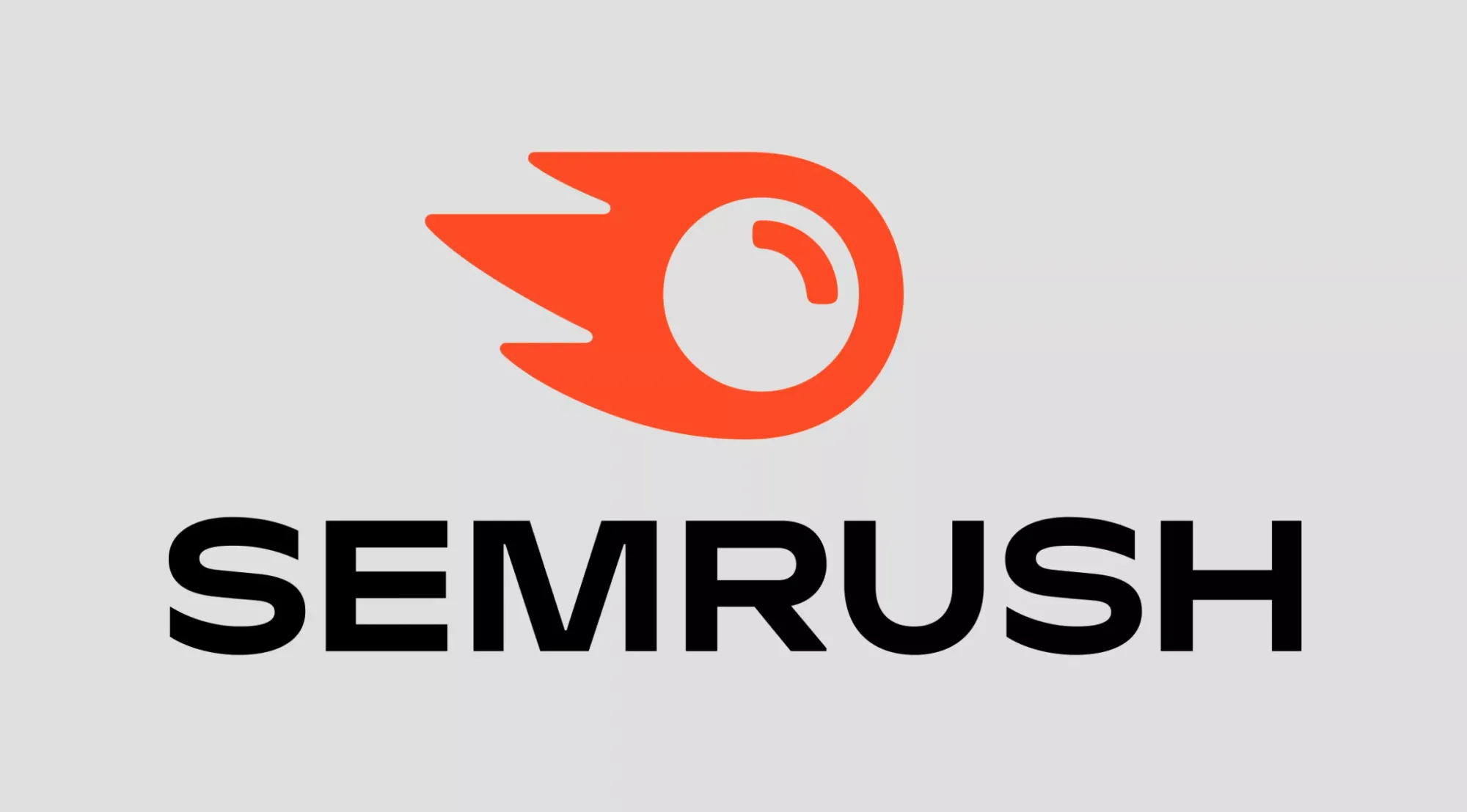
What is SEMrush?
In simple terms, SEMrush is likely the most widely used and recognized SEO tool on this list. Similar to Ahrefs, it offers a wide variety of SEO tools, making it one of the best options for anyone seeking help with SEO.
Semrush is a top-notch software that helps with finding keywords, checking out your competition, and making your Google ads better.
But it also does much more than that: Semrush can be used for everything! (in the world of SEO and digital marketing, of course)
Who is SEMrush for?
SEMrush is ideal for marketers and businesses focused on various digital marketing strategies, including SEO, PPC, content marketing, and social media management.
When compared to Ahrefs, SEMrush offers a wider range of features and applications. By saying that, SEMrush is suitable for a larger audience.
How much does SEMrush cost?
SEMrush offers three main pricing tiers: Pro, Guru, and Business.
The Pro plan is ideal for freelancers and startups, offering basic features at a lower cost.
The Guru plan includes advanced features suitable for small to medium-sized businesses, while the Business plan offers comprehensive tools for larger enterprises with more extensive marketing needs.
Pricing varies based on the chosen plan and subscription length.
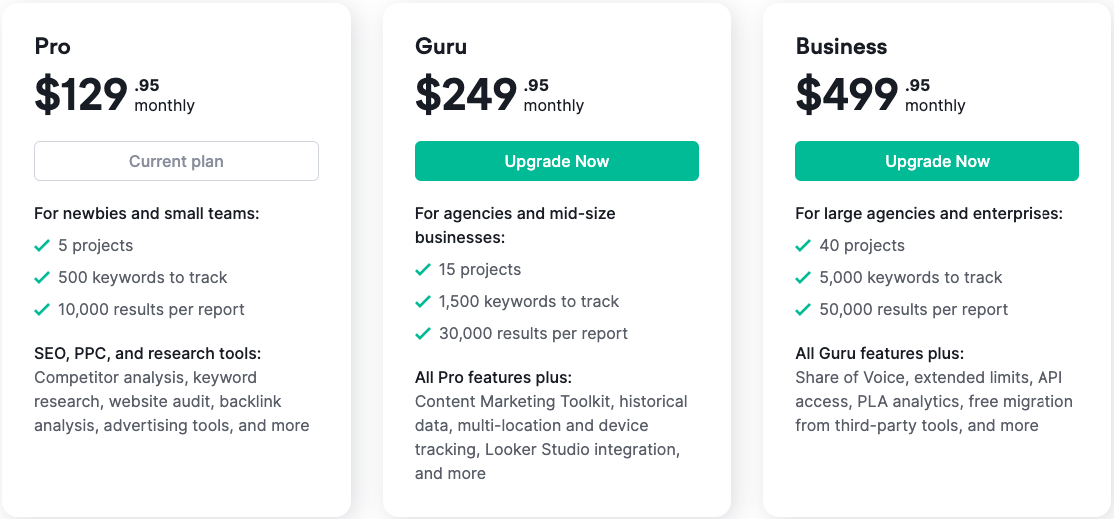
How to use SEMrush?
Using SEMrush is a breeze: simply type in your website or keywords, and it'll give you insights on your online visibility, competitors, and potential keywords to target.
Its user-friendly interface makes it easy to navigate through the data and understand your digital marketing opportunities.
With SEMrush, you can quickly identify areas for improvement and take actionable steps to boost your online presence without any hassle.
Pros
- Free forever plan available
- Great organic and PPC keyword research tools
- Competitors analysis (keyword gap)
- Daily rank tracking
- Seven-day-money-back guarantee
Cons
- Free plan is really limited
- Expensive paid plans
3. Moz Pro
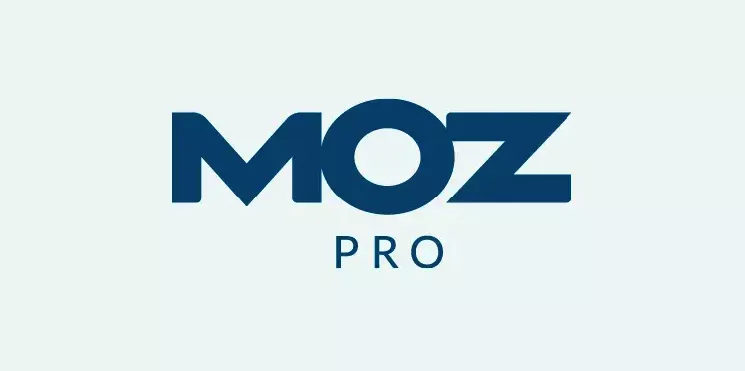
What is Moz Pro?
In straightforward terms, Moz Pro is another really popular and efficient SEO tool featured on this list.
While it shares common ground with Ahrefs and SEMrush in terms of functionality, Moz Pro sets itself apart with unique insights and an exceptionally user-friendly interface, especially suitable for those new to SEO.
Who is Moz Pro for?
Moz Pro is great for marketers and companies that need help with SEO, whether they're beginners or more advanced.
It's simpler to use than SEMrush and Ahrefs, making it a good pick for those who are new to SEO. Still, it offers enough depth that seasoned pros will find it useful too.
How much does Moz Pro cost?
Moz Pro offers several pricing plans tailored to different needs, similar to SEMrush and Ahrefs.
Compared to SEMrush and Ahrefs, Moz Pro aims to deliver value at competitive pricing, making it accessible for a broad range of users from beginners to experienced marketers.
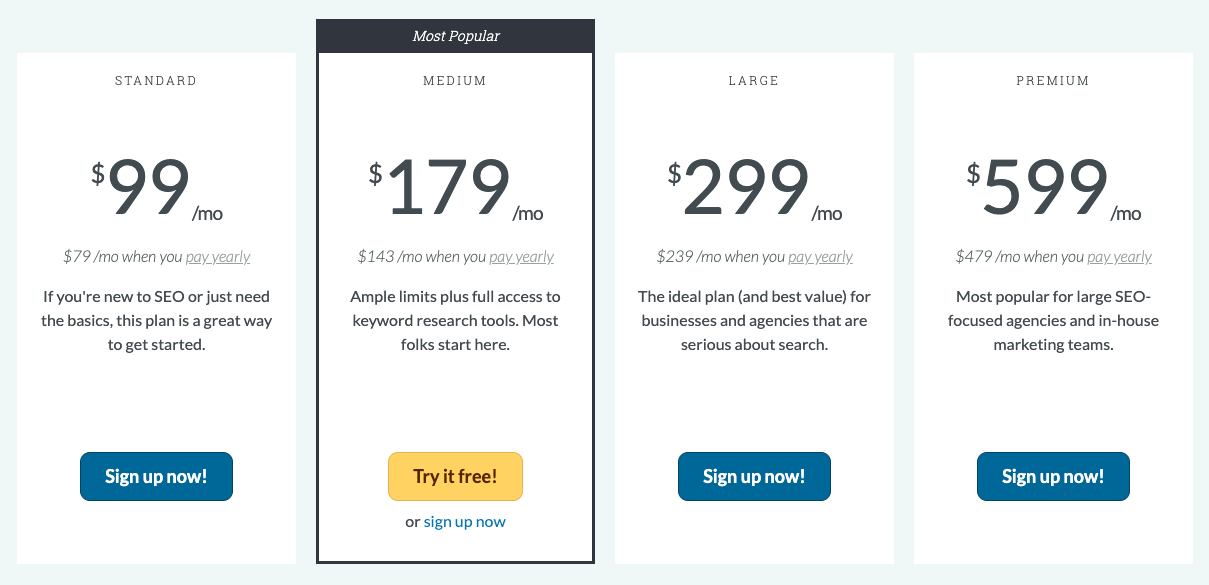
For detailed and current pricing information, you should visit the Moz Pro pricing page directly.
How to use Moz Pro?
Pros
- Detailed metrics
- Optimization tips and insights
- Competitive pricing
Cons
- Navigation
- Lacking features
4. Yoast SEO (for WordPress users)
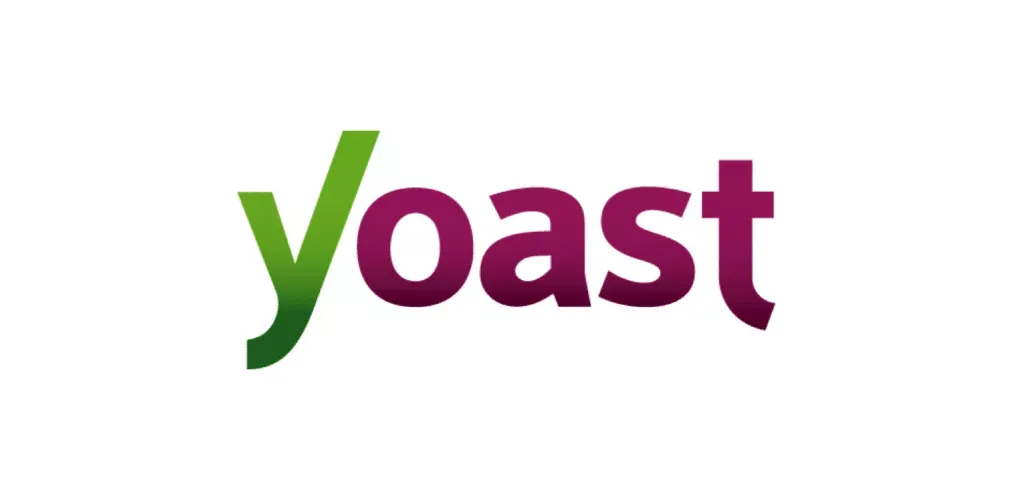
What is Yoast SEO?
Yoast SEO is different from the previous three because it's less a tool and more a plugin made just for WordPress websites, helping you with SEO in an easily accessible way.
Unlike SEMrush, Ahrefs, and Moz Pro, which are good for all kinds of sites and SEO tasks, Yoast focuses on making WordPress sites shine in search rankings.
Who is Yoast SEO for?
Basically, Yoast SEO is for WordPress site owners who want to optimize their site for search engines without needing deep technical knowledge.
How much does Yoast SEO cost?
Yoast SEO has a few pricing options: Free, Premium for $89/year, and Premium+ for $329/year.
With the paid plans, you get extra features like useful redirection tools and suggestions for linking within your site.
Plus, the top-tier plan throws in round-the-clock support and unlimited keyword optimization.

Check out the complete list of Yoast SEO features included in each plan on their detailed pricing page.
How to use Yoast SEO?
Pros
- Intuitive interface
- Extremely customizable
- Great scoring system for every post
Cons
- Not enough tutorials/lessons
- Social media previews are limited
By integrating these SEO tools into your website, you can significantly boost your small business lead generation efforts.
They give you important info about how well your website is doing, so you can make smart choices about your marketing.
Keep checking and updating your SEO tactics regularly to make sure your business keeps doing well in the online world where competition is tough.
How to generate leads on social media?
Building strong relationships on social media is key to drawing in leads. Trust and authenticity make people more likely to engage with your service or product.
With the right strategies, you can turn your social media presence into a powerful lead generation tool.
1️⃣ Optimize Your Profiles for a Strong First Impression:
Use a professional profile picture or logo, and craft an engaging bio that highlights your unique value proposition.
Include a clear call-to-action (CTA), such as “Contact us,” “Download our guide,” or “Sign up for free.”
Link to a landing page optimized for lead capture.
2️⃣ Engage Actively to Build Genuine Connections:
Respond to comments, messages, and mentions promptly to foster trust and show that you value interactions.
Participate in relevant groups and discussions to position yourself as an approachable expert.
Use polls, Q&A sessions, and live videos to encourage two-way communication.
3️⃣ Share Valuable, Audience-Focused Content:
Create content that addresses common pain points or answers pressing questions your audience has.
Use storytelling and case studies to showcase how your product or service solves real-world challenges.
Repurpose high-performing content into different formats, such as turning a blog post into an infographic or a webinar into a short video.
4️⃣ Set KPIs and Maintain a Consistent Schedule:
Define key performance indicators (KPIs) like engagement rate, click-through rate (CTR), and lead conversions to measure success.
Use scheduling tools like Buffer, Hootsuite, or HubSpot to plan and automate posts, ensuring consistent visibility.
Analyze performance metrics regularly to refine your strategy.
5️⃣ Tailor Your Approach for Each Platform:
LinkedIn: Ideal for B2B lead generation, use tools like LinkedIn Sales Navigator to identify and connect with decision-makers.
Instagram and TikTok: Perfect for visually-driven B2C brands, focus on storytelling, influencer partnerships, and user-generated content.
Facebook: Leverage groups and targeted ads to engage specific audiences effectively.
6️⃣ Leverage Automation Tools for Precision and Efficiency:
Use tools like HubSpot or Sprout Social to automate lead generation tasks, such as publishing targeted campaigns or tracking engagement.
Employ chatbots for real-time interactions and lead qualification, enhancing response time and user experience.
Social media lead generation is not just about acquiring new contacts; it’s about creating a community of loyal followers who will advocate for your brand.
By nurturing these connections, you’ll establish lasting relationships that drive repeat business and referrals.
Engagement through social media: A step-by-step guide
Creating a vibrant social media presence is crucial for small business lead generation. Engaging effectively on social platforms can transform your brand's reach, turning passive viewers into active participants and leads.
Here's a week-long social media campaign plan designed to boost engagement and foster meaningful connections with your target audience.
Day 1: Set objectives and understand your audience
Understanding your audience and defining clear goals are essential for a successful campaign. Day 1 focuses on setting measurable objectives and using platform-specific insights to build a solid foundation for your strategy.
Objectives: Increasing followers by 5% within a month and boost engagement rates by 10% across all platforms.
Expected outcome: Gain a detailed understanding of your audience demographics, preferences, and behaviors. Establish precise, data-driven campaign goals.
Use Facebook Insights to analyze engagement metrics. Identify which posts performed best in terms of likes, shares, and comments.
Study audience demographics, such as age, location, and interests, to tailor future content.
Access Instagram Analytics to evaluate which content types—stories, reels, or static posts—achieve the highest reach and engagement.
Note when your followers are most active and schedule posts during those times for maximum impact.
✅ X (formerly Twitter)
Review tweet impressions and engagement rates using X Analytics.
Identify trending topics, hashtags, or tweet formats that resonate with your audience.
Check LinkedIn Post Analytics to see which professional content, such as industry news or thought leadership posts, garners the most attention.
Examine your audience's job roles and industries to align content with their professional interests.
Dive into Pinterest Analytics to track the performance of pins and boards.
Identify which visual styles, keywords, or themes drive the most saves and clicks.
Day 2: Content creation and scheduling
Creating and scheduling engaging content is crucial to keeping your audience interested and fostering meaningful interactions. On Day 2, the focus shifts to developing a diverse, audience-focused content calendar tailored to the dynamics of each platform.
- Objective: Create and schedule engaging, relevant content that aligns with your audience's preferences and campaign goals.
- Expected outcome: A well-rounded content calendar with platform-specific content that encourages interaction, builds relationships, and drives engagement.
Craft posts that spark engagement, such as quizzes, polls, or live Q&A sessions.
Schedule posts using tools like Meta Business Suite to ensure consistent visibility.
Incorporate visuals like infographics or short videos to increase click-through rates.
Plan visually compelling content, including carousel posts, reels, and stories.
Use interactive elements like polls, question stickers, or countdowns in stories to boost engagement.
Schedule posts at optimal times using tools like Later or Hootsuite to maximize reach.
✅ X (formerly Twitter)
Create a mix of tweets including short, snappy text posts, engaging images and infographics, and polls or questions to spark conversations
Use tools like TweetDeck or Buffer to schedule tweets for steady engagement throughout the day.
Write and schedule insightful articles, professional tips, or industry news updates to position your brand as a thought leader.
Share client success stories or behind-the-scenes posts to humanize your brand.
Use LinkedIn’s native publishing tools to time posts for maximum impact among B2B audiences.
Design captivating pins with high-quality visuals and overlayed text for clarity.
Focus on creating content-rich pins, like how-to guides or infographics, to inspire action.
Schedule pins with tools like Tailwind to ensure a steady stream of activity.
Day 3: Launch interactive features
Interactive features are key to driving engagement and fostering real-time connections with your audience. By using platform-specific tools effectively, you can spark meaningful conversations and create a more dynamic online presence.
- Objective: Boost user interaction through dynamic and interactive social media features.
- Expected outcome: Higher engagement rates, stronger connections with your audience, and increased brand visibility through direct communication.
Host a Facebook Live Event: Choose a topic your audience cares about, such as tips, tutorials, or a product demo.
Use real-time polls or Q&A features during the event to boost engagement and gather audience feedback.
Repurpose the live session into bite-sized clips for future posts.
Run Interactive Stories: Use polls, quizzes, or "Ask Me Anything" (AMA) stickers in your Instagram Stories to encourage participation.
Post behind-the-scenes content or real-time updates to make your brand more relatable.
Share user-generated content from story interactions to acknowledge your followers and inspire further engagement.
✅ X (formerly Twitter)
Organize an X Chat: Host a discussion on a trending topic using a branded hashtag to centralize the conversation.
Share thought-provoking questions to spark replies and retweets.
Post a follow-up thread summarizing key insights and tag participants to maintain visibility.
Create and Promote a LinkedIn Group: Start a professional group focused on your industry or a specific niche.
Regularly share exclusive content, host discussions, or conduct polls within the group.
Engage personally by responding to member posts to foster a sense of community.
Encourage Pin Comments and Discussions: Add engaging questions to pin descriptions to prompt user comments.
Host a Pinterest Challenge where followers create boards based on a theme and tag your account.
Collaborate with influencers or your audience by showcasing their pins for additional engagement.
Day 4: Monitor and respond
- Objective: Stay active and responsive to user interactions.
- Expected outcome: Strengthened relationships with your audience, leading to increased trust and loyalty.
Engage with Comments and Messages: Regularly monitor your posts for comments and respond promptly with thoughtful replies.
Check and reply to direct messages, offering helpful information or redirecting users to additional resources.
Use Facebook’s auto-reply feature to ensure timely responses when immediate engagement isn’t possible.
Reply to Comments and Mentions: Actively respond to comments on your posts and stories, acknowledging positive feedback or answering questions.
React to mentions in user-generated content by resharing and tagging the original creator to amplify engagement.
Use quick reply templates for FAQs to streamline the process while keeping responses personal.
✅ X (formerly Twitter)
Monitor Mentions and Conversations: Track brand mentions, hashtags, and replies using tools like TweetDeck or Hootsuite.
Engage in conversations by replying to comments or retweeting relevant posts to show attentiveness.
Proactively address concerns or feedback to demonstrate excellent customer care.
Respond to Comments and Participate in Discussions: Reply to comments on your posts with insightful answers that showcase your expertise.
Join industry-related group discussions to expand your reach and build credibility.
Personalize responses when connecting with new followers or accepting connection requests.
Engage with Pin Comments: Monitor comments on your pins and reply to questions or feedback to maintain an active presence.
Share pins or boards created by your followers that align with your brand, giving credit to their creators.
Offer tips or additional insights in your comments to add value to your audience.
Day 5: Collaborate and cross-promote
Collaboration and cross-promotion are powerful strategies to expand your reach, access new audience segments, and enhance your brand’s visibility. By partnering with complementary businesses, influencers, or industry experts, you can amplify your message and build credibility.
- Objective: Extend your reach through strategic partnerships and cross-promotion efforts.
- Expected Outcome: Access to new audience segments, increased engagement, and enhanced brand authority.
Co-Host a Facebook Live Event: Partner with a related business or influencer to host a live discussion, Q&A, or tutorial on a mutually relevant topic.
Share each other’s content by tagging and mentioning the partner in your posts, boosting exposure for both brands.
Promote the event on both pages leading up to the collaboration for maximum attendance.
Feature Partners in Stories or Posts: Collaborate with influencers or brands in your niche by sharing shoutouts, conducting interviews, or doing story takeovers.
Use co-branded hashtags to centralize content and encourage audience participation.
Highlight user-generated content that involves your partner’s products or services for added authenticity.
✅ X (formerly Twitter)
Host a Joint X Chat: Choose a trending topic relevant to your shared audiences and co-moderate a discussion.
Cross-promote tweets by retweeting or commenting on each other’s posts, adding value to your partner’s content while reaching their followers.
Use branded hashtags for the chat to boost visibility and engagement.
Co-Author an Article: Team up with a peer, thought leader, or industry expert to write an insightful article on a shared topic of interest.
Conduct and share a collaborative video interview or webinar to leverage both audiences.
Share recommendations or endorsements to strengthen professional relationships and reach new connections.
Collaborate on Shared Boards: Partner with other pinners or brands to curate a collaborative board featuring complementary pins that align with your audiences’ interests.
Host a Pin Exchange where you share each other’s pins and tag the original creator for mutual promotion.
Create a themed content series in partnership with a collaborator, such as a holiday gift guide or seasonal trends.
Day 6: Analyze and adjust
Continuous improvement is key to long-term success. On Day 6, focus on evaluating your campaign's performance to understand what worked, identify areas for improvement, and refine your strategy for the future.
- Objective: Assess the performance of your campaign to identify successful strategies and areas for optimization.
- Expected outcome: Actionable insights that inform future campaigns, leading to improved engagement, reach, and ROI.
Use Facebook Insights to analyze engagement metrics such as likes, comments, and shares.
Identify the types of posts (e.g., videos, polls, or live events) that performed best and adjust your content mix to prioritize these formats.
Review audience demographics to ensure your messaging aligns with your target audience.
Use Instagram Analytics to assess the performance of posts, reels, and stories.
Focus on metrics such as reach, interactions, and completion rates for stories to identify high-performing content.
Test different posting times and visual styles to refine your content strategy based on what resonates most with your audience.
✅ X (formerly Twitter)
Track impressions, engagement rates, and link clicks using Twitter Analytics.
Evaluate which tweet formats (e.g., text, images, or polls) drove the most interactions and replicate their success in future campaigns.
Monitor hashtag performance to optimize their usage in your tweets.
Analyze your posts’ performance with LinkedIn Analytics, focusing on metrics like impressions, clicks, and comments.
Determine which articles or updates attracted the most engagement and explore similar themes or formats.
Assess the success of LinkedIn Groups or collaborations to refine your approach to community engagement.
Use Pinterest Analytics to identify your most popular pins and boards based on saves, clicks, and impressions.
Study trends in visual styles, topics, or pin descriptions that appealed to your audience.
Plan future content around high-performing themes or create new boards that align with these preferences.
Day 7: Engage your sales team
Social media insights can be a goldmine for your sales team, helping them better understand customer behavior, preferences, and engagement trends. By integrating social media successes into your sales process, you create a cohesive strategy where online engagement drives meaningful sales outcomes.
- Objective: Leverage social media insights to enhance sales strategies, optimize workflows, and support lead generation efforts.
- Expected outcome: A unified approach where social media engagement informs and empowers the sales team, driving higher-quality leads and improving customer interactions.
Share performance data from top-performing posts, such as those with high engagement or shares, with your sales team.
Highlight audience demographics or trends (e.g., interest in a specific topic) to guide personalized sales pitches.
Use successful post themes to inform conversation starters or follow-up strategies.
Showcase engagement tactics like polls, question stickers, or comments that resonated with followers.
Collaborate with the sales team to integrate these tactics into direct messages or personalized outreach.
Use insights from visually popular posts to refine visual content in sales presentations or pitches.
✅ X (formerly Twitter)
Analyze tweet engagement metrics, such as retweets, likes, or comments, to identify customer interests or pain points.
Share examples of tweets that sparked conversations to inspire personalized sales outreach.
Discuss hashtag and topic trends that align with audience preferences for targeted engagement.
Share successful post insights, including those related to industry trends or customer pain points, to inform sales discussions.
Encourage the sales team to leverage thought leadership posts or articles to position themselves as trusted advisors.
Collaborate on LinkedIn InMail campaigns, integrating insights from content engagement.
Highlight popular pins or boards that reflect customer preferences or emerging trends.
Share this data with your sales team to help them personalize their approach based on specific themes or visual preferences.
Use high-performing pin topics to identify seasonal or niche opportunities for outreach.
Remember, the key to success is consistency, authenticity, and a willingness to adapt based on audience feedback and engagement metrics.
Email marketing: Personalized campaigns for higher conversion rates
When it comes to email marketing, making your messages personal really matters. It's not just a trendy term—it actually works to get people more interested and to take action.
Think about it like this: when you get an email that seems like it's just for you, you're more likely to pay attention, right?
So, by using handy tools like HubSpot or Mailchimp, companies can set up automated emails that don't feel like they're shouting at everyone at once.
Instead, these emails feel like they're just chatting with you. It makes the whole experience feel more genuine and tailored just for your needs and likes.
Here are some tips for effective follow-up emails:
- Personalize greetings to create a connection.
- Focus on the customer's needs to show understanding.
- Provide value in every interaction.
- Use a soft call to action to guide, not push.
Avoid common pitfalls such as a salesy tone, triggering spam filters, or reaching out to the wrong contacts. Keep your emails concise and clear to respect your leads' time.
Keep in mind, these figures are just a baseline. The unique characteristics and value your business offers can significantly impact these rates.
Crafting your email: Templates and tools
Email marketing plays a vital role in getting and keeping potential customers interested. With the right templates and tools, you can attract new leads, keep them interested, and stay connected with them at every stage.
Below, you'll find tailored email templates for various points in the customer's journey, plus tips on using personalization and automation tools to step up your email game.
Awareness stage: Introduction email template
Your introduction email should warmly welcome subscribers and succinctly introduce your brand's value proposition. Aim to pique interest without overwhelming the reader with too much information.
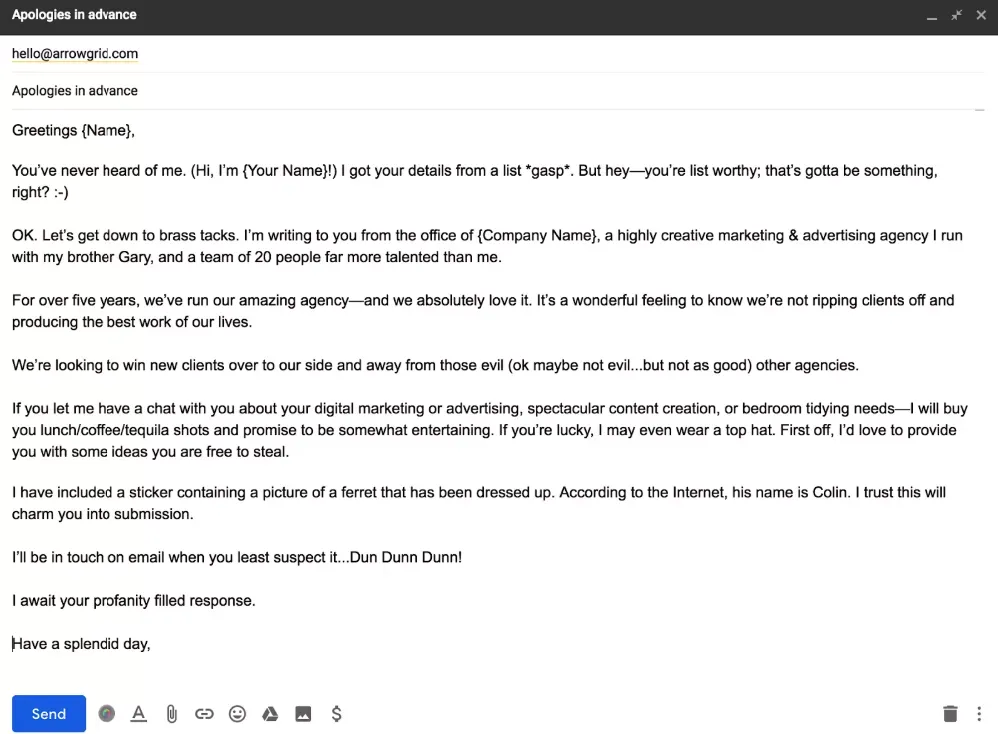
Template:
Subject: Start Your Journey with [Your Brand] Today!
- Body: Hello [Name],Welcome aboard! We're delighted to share our journey with you. At [Your Brand], we empower you with [mention your unique selling points or solutions].Discover our story and what we can offer by clicking [Link to learn more].Looking forward to growing together,[Your Name]
Tool recommendations
- ConvertKit: Stands out for its audience segmentation capabilities, perfect for tailoring messages at this stage.
- AWeber: Offers a wide range of templates and autoresponder options, helping to maintain engagement from the start.
- GetResponse: Provides excellent automation services and detailed analytics to gauge the effectiveness of your introduction emails.
Actionable tips & tricks:
- Embed a clear, compelling call to action.
- Use an engaging subject line to boost open rates.
- Incorporate educational content that aligns with your brand's values.
How does it effect lead generation?
The introduction email is vital for establishing a connection and setting the stage for ongoing engagement. It's an opportunity to differentiate your brand and lay the groundwork for a lasting relationship.
Consideration stage: Educational content email template
At this stage, your goal is to provide value through relevant and informative content. Demonstrate your expertise and industry knowledge to build credibility and trust.
Template
Subject: Dive Deeper into [Industry Topic] with Our Latest Insights
Body: Hi [Name],
Are you ready to explore new dimensions of [Industry Topic]? We've compiled our best resources to guide you through [specific subject matter], offering fresh perspectives and actionable advice.
Unlock your exclusive content here: [Link to Download]
Stay informed, [Your Brand Team]
Tool recommendations
- ConvertKit: Its segmentation features are ideal for sending targeted educational content.
- HubSpot: Provides all-in-one marketing solutions with strong email tools and content management systems, beneficial for a cohesive strategy.
- Drip: Excels in e-commerce marketing, allowing for personalized content based on customer behavior and interests.
Actionable tips & tricks
- Focus on delivering value and relevant insights.
- Maintain a consistent, educational tone throughout your email.
- Include a direct, easy-to-find call to action for accessing the content.
How does it effect lead generation?
Educational content nurtures leads by providing them with valuable knowledge and insights, fostering trust and establishing your brand as an authority. This helps move potential customers further along in their decision-making process.
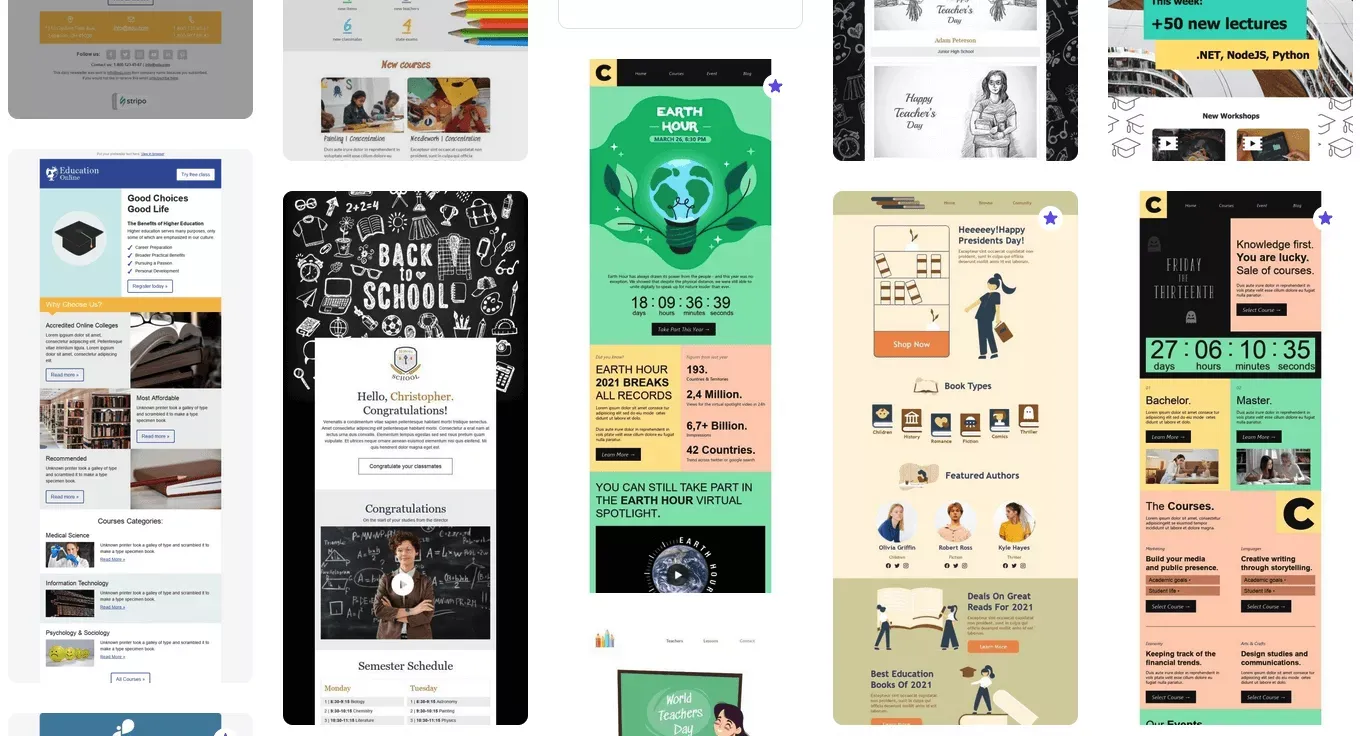
Decision stage: Testimonial and case study email template
Showcase the success stories of your existing customers to build credibility and illustrate the real-world value of your products or services.
Template
Subject: Discover How [Your Brand] Transformed [Customer's Business]
Body: Hi [Name],
Ever wondered how [Your Brand] can make a difference? Here's a story we're excited to share: how we helped [Customer/Company] overcome [specific challenge] and achieve [specific results].
Read the full story here: [Link to case study/testimonial]
Imagine what we can do together,
[Your Brand Team]
Tool recommendations
- ActiveCampaign: Known for its advanced automation capabilities, ideal for sending targeted testimonial emails.
- Campaign Monitor: Offers beautiful design options to showcase your case studies compellingly.
- Marketo: Provides robust marketing automation features that can enhance the impact of your decision-stage emails.
Actionable tips & tricks:
- Highlight specific benefits and results from the testimonial or case study.
- Use a clear, engaging subject line that emphasizes the value proposition.
- Include a strong call to action encouraging the reader to learn more or reach out for consultation.
How does it effect lead generation?
Testimonials and case studies provide social proof, reassuring potential customers of your credibility and the effectiveness of your solutions.
They play a critical role in the decision-making process, tipping the scales towards conversion.
Retention stage: Feedback and follow-up email template
After a sale, your relationship with the customer isn't over; it's just entering a new phase. The retention email is crucial for maintaining this relationship, encouraging repeat business, and gathering valuable feedback to improve your offerings.
Template
Subject: Your Thoughts Matter to Us, [Name]
Body: Hi [Name],
We hope you're enjoying [Product/Service]! At [Your Brand], we're constantly striving to deliver the best experience and your feedback is vital to us.
Could you spare a few moments to share your thoughts? [Link to survey]
To show our appreciation, here's a [Discount/Offer] for your next purchase. Thank you for being part of our community!
Best, [Your Brand Team]
Tool recommendations and comparisons
- Klaviyo: Excellent for personalized campaigns and leveraging customer data effectively.
- SurveyMonkey: Integrate surveys directly into your emails to collect feedback efficiently.
- Customer.io: Allows you to automate nuanced, data-driven email campaigns based on user actions and feedback.
Actionable tips & tricks
- Ensure the feedback process is as simple and straightforward as possible.
- Offer a token of appreciation for their time (e.g., a discount or exclusive content).
- Use the feedback collected to make tangible improvements and inform customers about changes you've implemented based on their suggestions.
How does it effect lead generation?
Feedback and follow-up emails show customers that you value their opinions and business, fostering loyalty and increasing the chances of repeat purchases.
Additionally, acting on feedback can improve your offerings and customer satisfaction, indirectly boosting lead generation as satisfied customers are more likely to refer others to your brand.
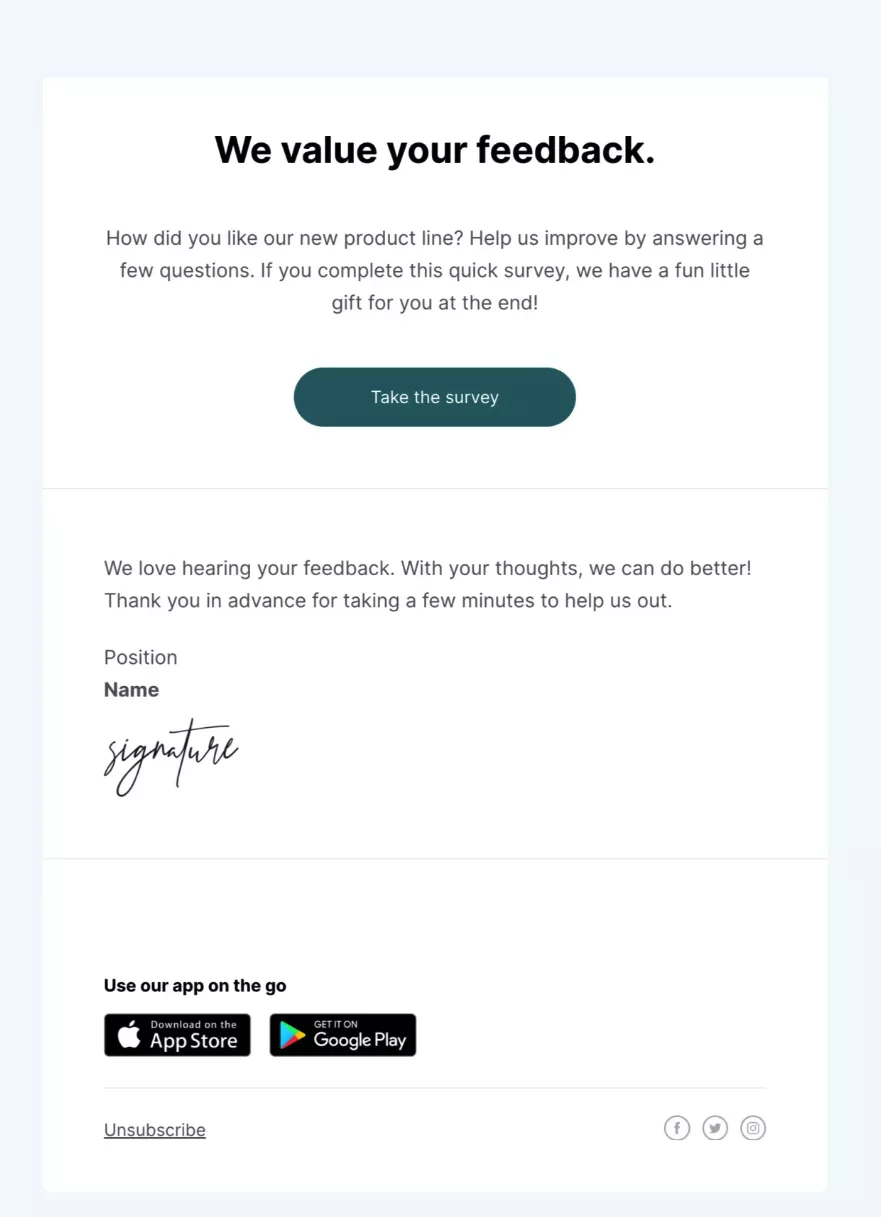
Analytics and refinement
Analyzing your email campaigns is crucial for understanding what resonates with your audience. Use these insights to refine your approach, optimize content, and improve engagement rates.
Example insights usage
- Monitor which emails have the highest open and click-through rates to identify topics and formats that engage your audience.
- Analyze conversion rates to see which calls to action and content types are most effective at driving action.
- Adjust your email strategy based on these insights to enhance future campaigns.
Tool recommendations and comparisons:
- Google Analytics: Integrates with many email platforms, offering deep insights into user behavior and campaign performance.
- Kissmetrics: Provides detailed analytics focused on individual user journeys, great for understanding nuanced behaviors.
- Mixpanel: Offers advanced segmentation and analytics, allowing for detailed performance analysis at various campaign stages.
Actionable tips & tricks:
- Set clear KPIs for each campaign to measure success effectively.
- Regularly review analytics data to identify trends and areas for improvement.
- Test different email elements (e.g., subject lines, CTA placements) to see what works best for your audience.
Importance and impact on lead-generation
By closely monitoring and refining your email marketing strategy based on analytics, you can continuously improve your approach, better engage
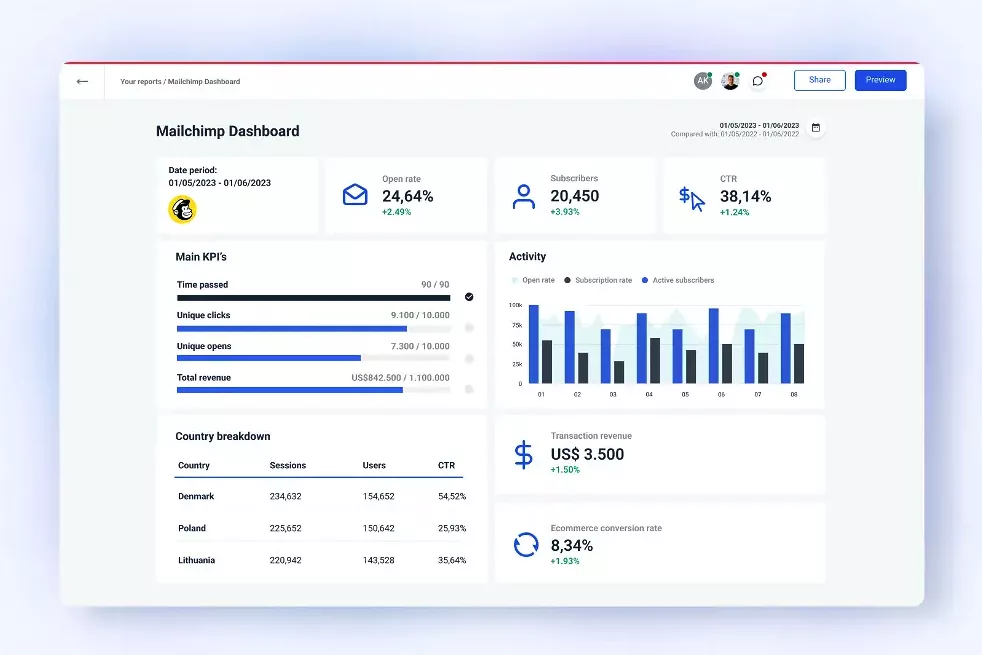
Using these templates and tools, you can develop an all-encompassing email marketing plan. This strategy will help you connect with potential customers no matter where they are in their journey, boost your efforts to attract leads, and give your sales team what they need to succeed.
Analyzing success and preparing for the future of lead generation
Gone are the days of shooting in the dark. Today’s small businesses have a powerful ally in their corner: analytics.
Understanding the right metrics can transform your lead generation from a game of chance to a science. A successful lead generation strategy involves understanding buyer personas, addressing visitor problems through targeted content, and continuously refining methods to maximize lead conversion rates.
Let's break it down:
- Reach & engagement: How far is your content traveling? Track impressions, clicks, likes, comments, and shares.
- Lead generation: Are your efforts bearing fruit? Analyze the performance of your lead acquisition funnel.
- Demographics: Who's listening? Tailor your strategies by understanding your audience.
Sales efficiency is crucial for maximizing profits. By optimizing resources and enhancing customer experience, you can increase revenue. Metrics like average deal size, conversion rate, and team performance are key. Here are some of the most tracked email metrics by email marketing managers worldwide:
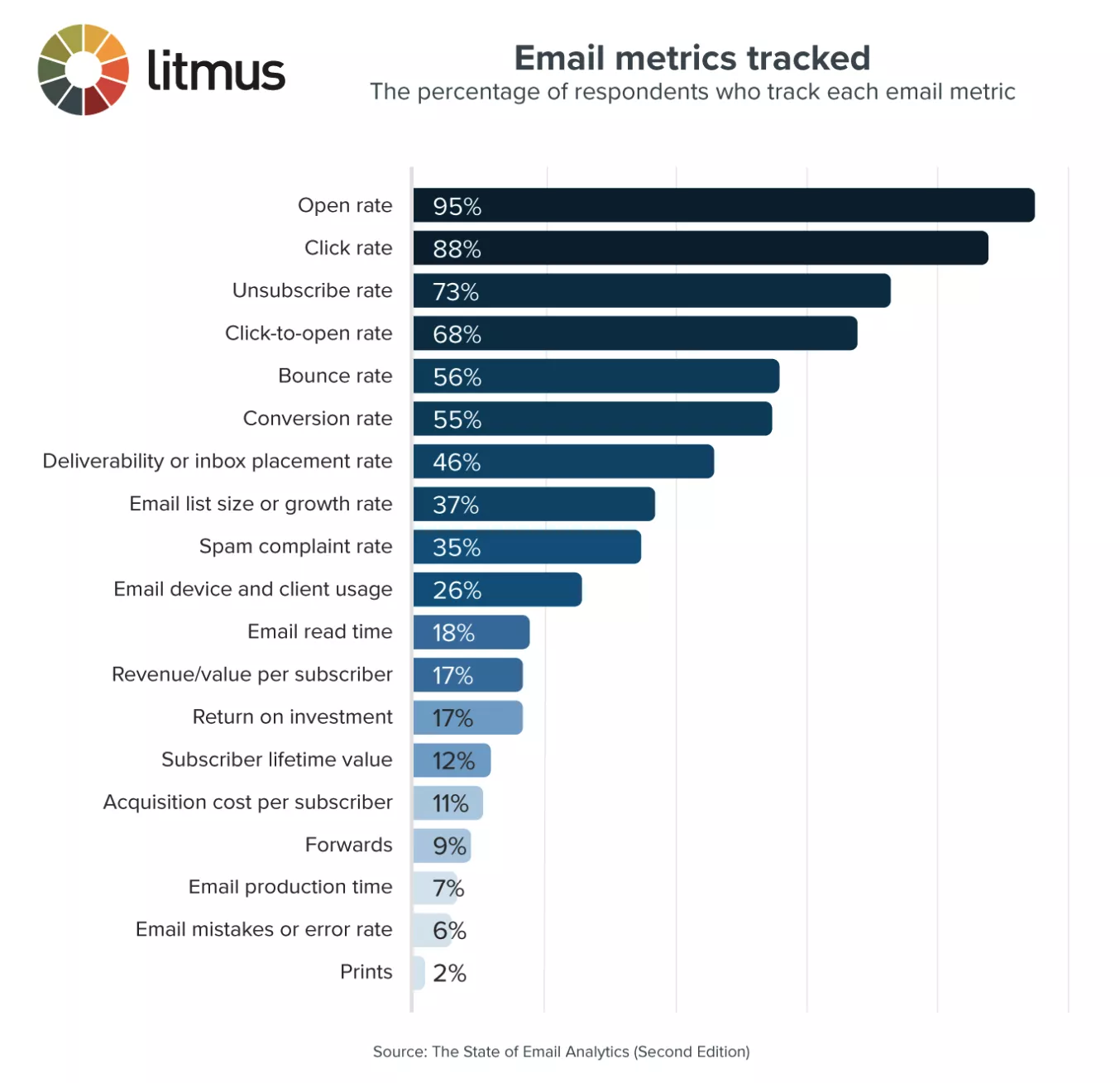
Remember, it’s not just about collecting data; it’s about making data-driven decisions. Use your analytics dashboard to ditch the guesswork and focus on what works. Refine, adjust, and watch your lead generation efforts thrive.
Quick analytics walkthrough
Tools like Google Analytics are crucial to refining your lead generation strategy and optimizing lead generation tactics.
This section provides a straightforward tutorial on setting up and interpreting key metrics in Google Analytics, offering actionable steps to get those leads coming.
How to set up Google Analytics?
- Account creation: Visit the Google Analytics website and sign up for an account. You'll need to provide your website's URL and follow the prompts to get your tracking code.
- Tracking code installation: Insert the tracking code into the header of every page on your website. This enables Google Analytics to start collecting data on your site's traffic and user interactions.
- Goal configuration: Set up goals in Google Analytics to track conversions, such as when a visitor fills out a contact form, signs up for a newsletter, or downloads a resource, marking a new lead acquisition.
What key metric to look at?
- Audience demographics and interests
- Google Analytics provides detailed reports on your audience's age, gender, interests, and geographical location.
- This helps you talk directly to the right people with your marketing.
- New vs. returning visitors:
- This metric gives insights into the loyalty and engagement of your audience.
- A healthy mix of new and returning visitors indicates your site is not only attracting new traffic but also retaining users, which is crucial for long-term growth.
- Pageviews and unique pageviews:
- Understanding which pages attract the most views can highlight content that resonates with your audience.
- Pages with low views might need revisiting for content improvement or better internal linking.
- Session duration and pages per session:
- These metrics can help you gauge the overall engagement level of your website.
- Longer session durations and higher pages per session typically indicate more engaging and valuable content to your visitors.
- Exit pages:
- Identifying where users are leaving your site can provide insights into potential issues with specific pages.
- Optimizing these exit pages can improve user experience and increase retention.
- Event tracking:
- Setting up event tracking allows you to monitor specific interactions on your site, such as button clicks, video plays, or downloads.
- This data is invaluable for understanding user engagement beyond basic page views.
- Mobile performance:
- With the increasing use of mobile devices, monitoring your site's performance on mobile is crucial.
- Google Analytics can help you understand how your mobile audience behaves compared to desktop users and optimize accordingly.
What are the most important steps?
- Segment your audience: Use Google Analytics' segmentation features to analyze specific groups of users based on demographics, behavior, or acquisition channels. This detailed view helps tailor your marketing efforts more effectively.
- Monitor bounce rates: High bounce rates on certain pages might indicate irrelevant content or a poor user experience. Identify these pages and experiment with alternative content, design, or navigation to retain visitors.
- Analyze user flow: Understanding the paths users take on your website can reveal popular content, unexpected exit pages, or bottlenecks in your conversion funnel. Use this information to streamline user experience and guide visitors toward conversion goals.
- Evaluate campaign performance: Track the success of specific marketing campaigns or sources of traffic. Determine which campaigns bring the most valuable users and adjust your strategies to replicate this success.
- Refine keywords: Use the Acquisition reports to identify which organic search terms are driving traffic to your site. Optimize your content for successful keywords and investigate why others underperform.
- Check device usage: Analyzing the devices your visitors use can inform website optimization for mobile, tablet, or desktop, ensuring a smooth user experience across all platforms.
- Assess page load times: Fast-loading pages improve user experience and SEO rankings. Identify slow-loading pages and optimize them to reduce bounce rates and improve engagement.
Amazing example of lead generation
Canva’s journey from a simple idea to over 1 million users within two years is an incredible example of effective lead generation. Lead generation companies play a crucial role in helping businesses acquire leads efficiently by providing tailored services and strategies to enhance their marketing and sales efforts. Here’s a breakdown of the strategies Canva employed to achieve this success:
- User-Centric Design: Canva understood the power of a user-friendly interface, making graphic design accessible to everyone, not just professionals. This approach attracted a broad user base, generating numerous leads.
- Freemium Model: By offering core features for free, Canva enticed users to try the platform without any financial commitment. This strategy not only increased sign-ups but also nurtured potential customers for their paid plans.
- Content Marketing: Canva provided valuable content that empowered users to create better designs. This content, shared widely across social channels and blogs, helped attract new users, demonstrating Canva’s value proposition directly.
- Community Engagement: Engaging with the community through social media, user groups, and design challenges, Canva built strong relationships with its users, encouraging word-of-mouth promotion and loyalty.
- Viral Features: Canva integrated features that encouraged sharing, like easy posting of designs to social media, which amplified its reach and attracted new users organically.
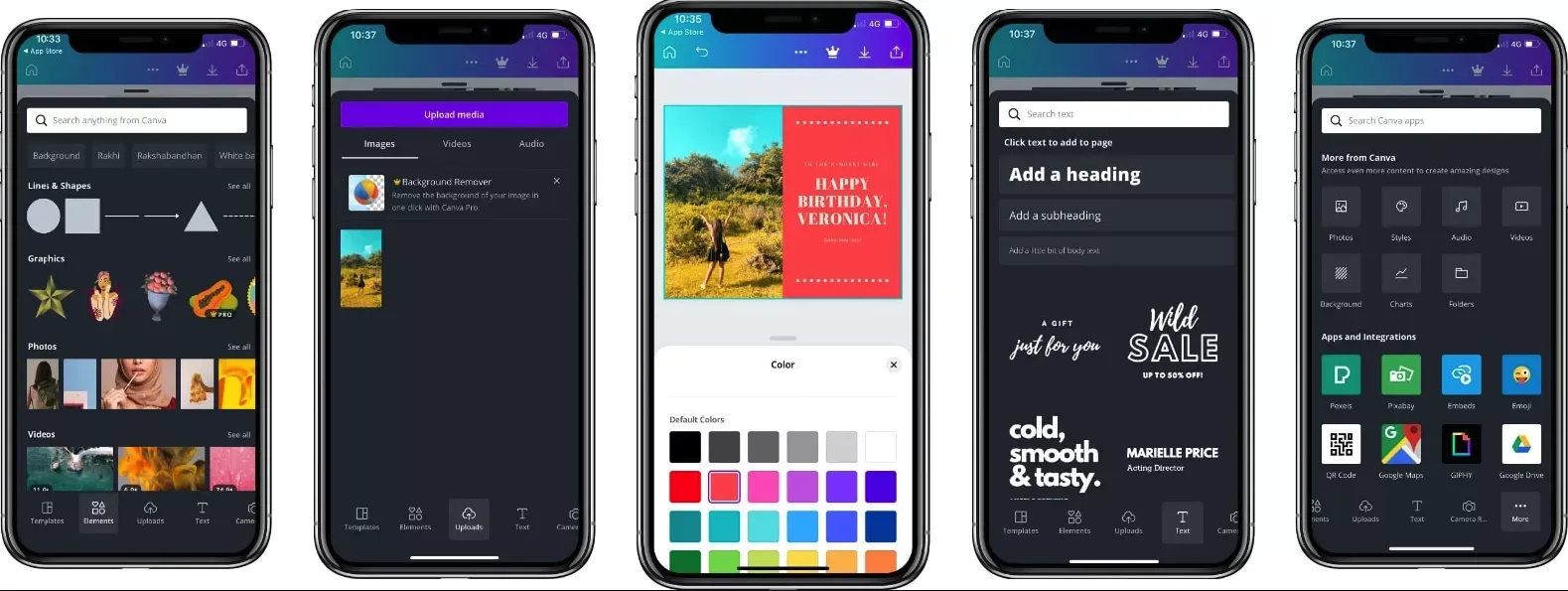
How is Canva preparing for the future?
Canva is bringing artificial intelligence (AI) into its tools, making it easier and faster to create designs. It has introduced features like Magic Replace, Magic Eraser, Magic Edit, and Magic Design.
These let users quickly change images, remove parts they don’t want, and get new design ideas. Canva also has an AI tool that helps write text for various projects, showing how it’s using AI to make design simpler for everyone.
A lead generation agency can also play a crucial role in helping businesses prepare for the future by providing specialized strategies, technology, and personalized outreach to generate qualified leads and grow sales pipelines.
Constantly updating with new features
Canva keeps adding new things to make sure users have what they need to create great designs. It recently added a Brand Hub, which helps users keep their designs consistent with their brand.
This includes setting up a brand look, organizing design assets, and making templates for common tasks. Canva also added new fonts and editing tools, showing it listens to its users and updates its platform to help them do their best work.
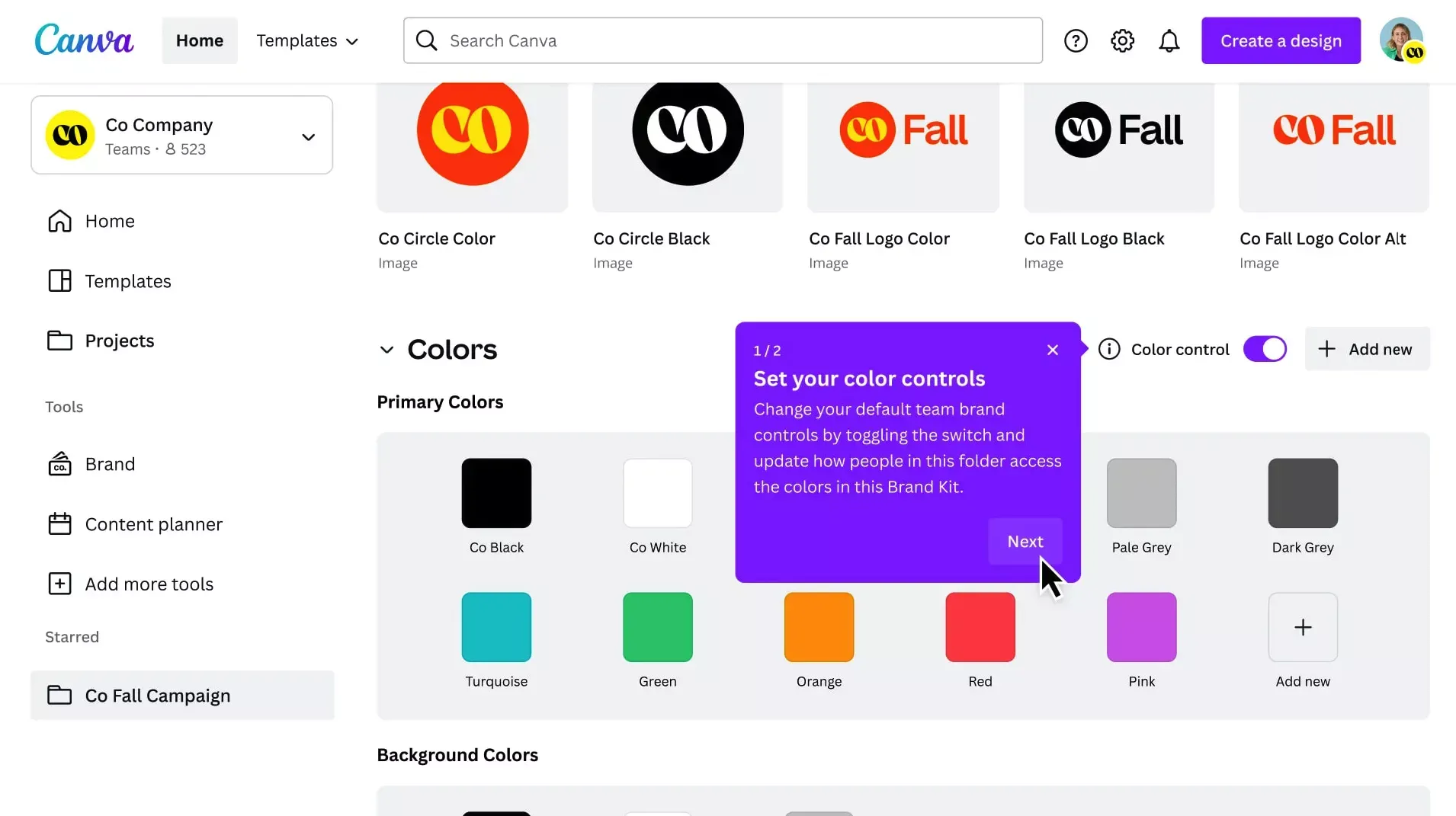
What can we learn from Canva?
Canva's lead generation success teaches us the importance of a user-focused product, a strategic freemium model, engaging content, active community involvement, and features that promote sharing.
These elements, when executed effectively, can significantly boost lead generation and user acquisition for any business.
Incorporating these insights into your own strategy can help emulate Canva's success, adapting their proven methods to your unique context and audience.
By keeping the explanation straightforward and actionable, the content remains accessible and valuable for readers, providing clear takeaways on how to leverage similar strategies for their lead generation efforts.
What lies ahead?
Staying on top of the latest trends in lead generation is crucial if you want your business to stand out and succeed. Here’s what to watch for as we move into 2024:
- Keep up with Google’s updates: Changes in search engines can significantly impact how visible your website is online.
- Explore account-based marketing (ABM): This focused strategy is becoming more popular because it targets specific accounts, making your marketing efforts more precise.
- Dive into intent-based lead generation: It’s important to understand what potential customers are looking for and use that knowledge to attract them.
Guiding leads through the sales funnel is essential for converting prospects into paying customers and ultimately driving revenue growth.
By adopting these trends early, you can give your business an advantage, helping it to adjust and prosper in a fast-changing environment. But it’s not just about jumping on the latest bandwagon. It’s about integrating these trends into a cohesive strategy that aligns with your business goals and customer needs.
By doing so, you can ensure that your lead generation efforts are not only current but also effective and efficient.
It's time to start leading.
As we finish our look at lead generation for small businesses, it's clear that getting good at this is crucial for your business to grow and do well.
We've seen how different methods, such as writing great content, using SEO, being active on social media, and sending out emails, can help you attract and win over new customers.
The real-life examples we checked out show that these methods really work!
The important thing is to keep checking and improving your ways to get leads.
Moving forward, keep an eye on new trends and tech that can help your business stand out.
By using these strategies and being ready to change when needed, your small business has everything it needs to succeed in getting more leads.
Want to know how lead generation can fuel your small business growth?
Start leading today with Propoze, and forget about writing another proposal ever again! Click on the button below and start closing new deals today!
Frequently asked questions on small business lead generation
Here are some of the most aksed questions on small business lead generation - and answers you've been looking for.
What are the most effective lead generation strategies for small businesses?
The most effective lead generation strategies for small businesses include leveraging content marketing to engage potential leads, optimizing for search engines (SEO), utilizing social media to build relationships and attract leads, and creating personalized email marketing campaigns for higher conversion rates.
How can small businesses measure the success of their lead generation?
Small businesses can measure the success of their lead generation efforts by understanding and analyzing key metrics and analytics.
This includes tracking website traffic, conversion rates, lead quality, cost per lead, and return on investment (ROI) to gauge the effectiveness of different strategies and campaigns.
What future trends should small businesses anticipate?
Small businesses should anticipate trends such as the increasing importance of artificial intelligence and machine learning in automating and personalizing lead generation processes, the growing relevance of video content, and the need for a strong mobile presence as consumers continue to shift towards mobile devices.